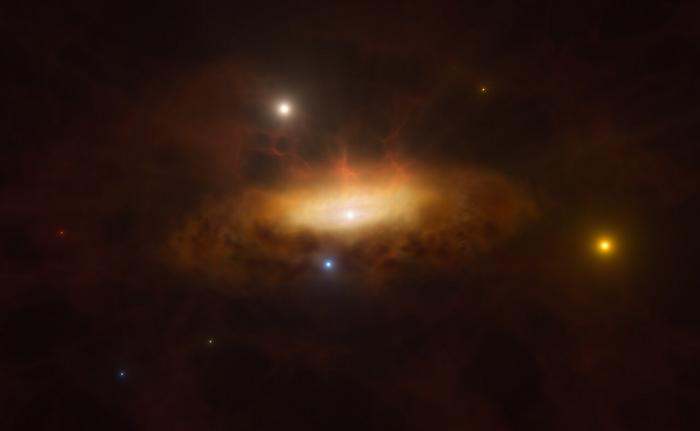Astronomers have observed an unprecedented event in the galaxy SDSS1335+0728, located 300 million light-years away in the constellation Virgo. In late 2019, the galaxy suddenly started shining brighter than ever before, and it continues to grow brighter even today, more than four years later. This unusual behavior has led astronomers to believe they are witnessing the awakening of a massive black hole at the galaxy’s core.
Using data from several space and ground-based observatories, including the European Southern Observatory’s Very Large Telescope (ESO’s VLT), astronomers have tracked the galaxy’s brightness variations. They found that SDSS1335+0728 is now radiating much more light at ultraviolet, optical, and infrared wavelengths, and it even started emitting X-rays in February 2024.
“Imagine you’ve been observing a distant galaxy for years, and it always seemed calm and inactive,” says Paula Sánchez Sáez, an astronomer at ESO in Germany and lead author of the study. “Suddenly, its [core] starts showing dramatic changes in brightness, unlike any typical events we’ve seen before.”
A Massive Black Hole Begins to Feast
The most likely explanation for this phenomenon is that the massive black hole at the center of SDSS1335+0728 has started to feed on the gas available in its surroundings, becoming very bright in the process. Massive black holes, with masses over one hundred thousand times that of our Sun, exist at the center of most galaxies, including the Milky Way, but they are usually dormant and not directly visible.
“[This] process (…) has never been observed before,” says co-author Lorena Hernández García from the Millennium Institute of Astrophysics (MAS) and the University of Valparaíso in Chile. Previous studies have reported inactive galaxies becoming active after several years, but this is the first time the awakening of a black hole has been observed in real-time.
Valuable Insights into Black Hole Growth and Evolution
While follow-up observations are still needed to rule out alternative explanations, such as an unusually slow tidal disruption event or even a new phenomenon, this galaxy provides valuable information on how black holes grow and evolve. Astronomers expect that instruments like MUSE on the VLT or those on the upcoming Extremely Large Telescope (ELT) will be key in understanding why the galaxy is brightening.
“Regardless of the nature of the variations, [this galaxy] provides valuable information on how black holes grow and evolve,” Sánchez Sáez says.
The study, which has been accepted for publication in Astronomy & Astrophysics, highlights the importance of continuous monitoring of galaxies and the potential for discovering new and exciting phenomena in the universe.
Headline: Astronomers Witness Unprecedented Awakening of Massive Black Hole in Distant Galaxy
Additional Resources for Readers
- Video: Active Galactic Nuclei (AGN): This will give readers a visual representation of AGN and how they function. You can find a video here: https://www.youtube.com/watch?v=1NW252Ylaww
- Citizen Science: Galaxy Zoo: This is a project where you can help classify galaxies and contribute to real scientific research. You can participate at https://www.zooniverse.org/projects/zookeeper/galaxy-zoo/classify.
- Black Hole Simulation: Explore the gravity and effects of a black hole through an interactive simulation. A good starting point is the Black Hole Simulator from NASA: https://spaceplace.nasa.gov/menu/black-holes/
If our reporting has informed or inspired you, please consider making a donation. Every contribution, no matter the size, empowers us to continue delivering accurate, engaging, and trustworthy science and medical news. Independent journalism requires time, effort, and resources—your support ensures we can keep uncovering the stories that matter most to you.
Join us in making knowledge accessible and impactful. Thank you for standing with us!

